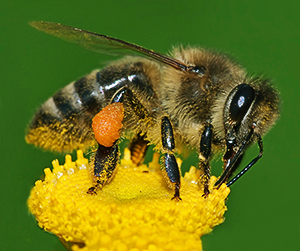
The European honey bee was first introduced into Australia by European Settlers in about 1822 to supply them with honey. It is venomous and is responsible the highest number of human deaths caused by wild animals in Australia.
Since their introduction, the European honey bees, have become vital to the Australian agricultural sector. Up to two-thirds of crops, such as apples, pears, melons, stone fruit, lucerne, cotton and canola rely on this bee for pollination. Almonds are 100% dependent on the European honey bee pollination. This bee is considered beneficial, but does have some detrimental effect on native bees and native plants that can only be successfully pollinated by native insects.
European Honey Bee - Description What Does a European Honey Bee Look Like?
Photo: European Honey Bee queen with workers
The European honey bee, excluding the queen which is very much larger, is approximately 1.3-1.6cm in length and has a dull orange-brown abdomen with brown bands around their abdomen. Its head, thorax and abdomen and legs are densely covered with hair. Bees are highly social insects living in large hives dominated by a queen bee who is much larger than the worker and drone bees and the only bee to lays eggs. Worker bees build and maintain the hive and collect pollen and nectar, and feed the developing bee larvae.
European Honey Bee - Danger to Humans Is the Honey Bee Venomous (Poisonous)?
Nearly 33% of all hospital admissions associated with human animal encounters are for bee and wasp stings. For most of us, a bee sting causes only localised pain and swelling However, some people have severe allergic reactions to bee stings can lead to anaphylactic shock and death.
Photo: Bee sting
It is estimated that it would take as many as 500 bee stings to cause death in a normal human. However about 3% of the population are allergic to bee venom. In the case of these people a single sting can be lethal. Within minutes of being stung, these allergic individuals may experience swelling of the throat, face, and lips, headache, dizziness, nausea and vomiting, difficulty breathing, decrease in blood pressure, weak and rapid heart rate and loss of consciousness leading the eventual death as a result of anaphylactic shock.